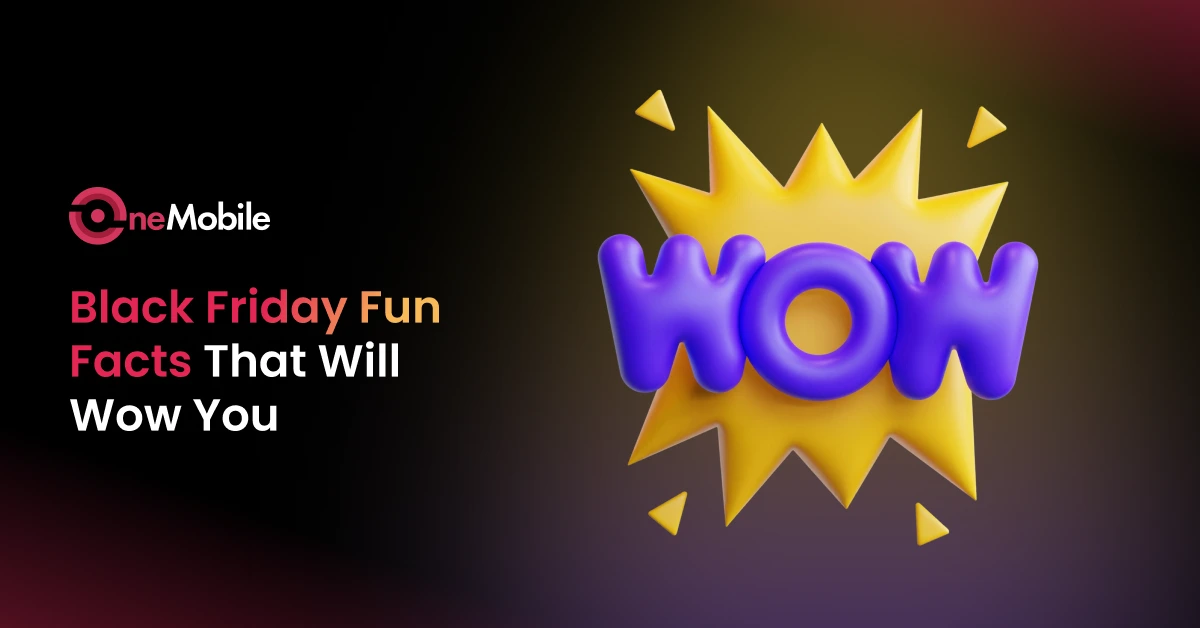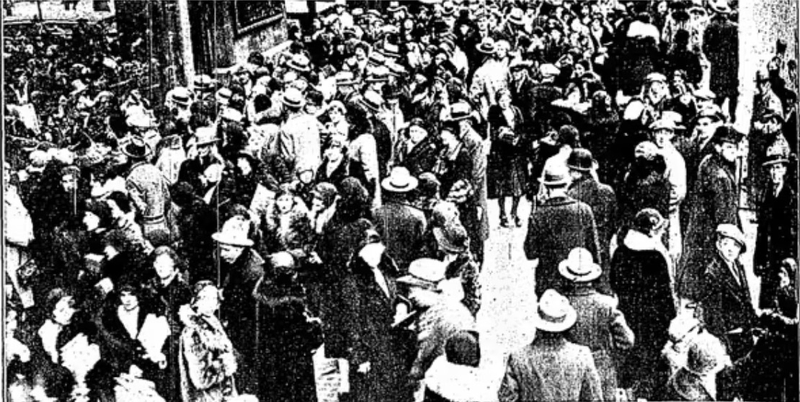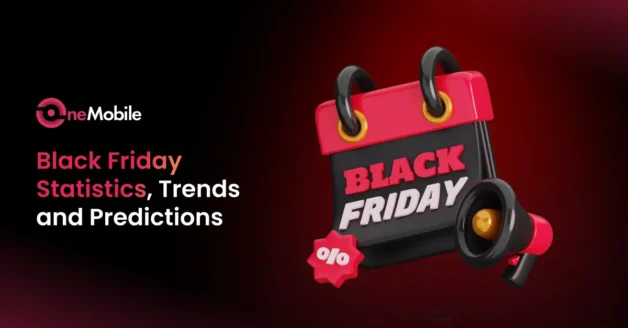October 24, 2025
12 Interesting Fun Facts About Black Friday: History, Surprising Stories, and the Truth Behind

Every November, as Thanksgiving ends, Black Friday marks the start of a global shopping tradition where consumers hunt for the best deals and retailers aim to boost year-end profits. In the U.S. alone, shoppers spend an average of $430 each, fueling billions in sales both online and in stores. Yet beyond the excitement and savings, Black Friday also reflects broader themes, from evolving consumer behavior and digital transformation to growing awareness of its environmental impact.
But have you ever wondered about the origin of BFCM and how it evolved into such a massive global event? From a single day of chaotic post-Thanksgiving sales to a week-long shopping festival that spans both online and offline markets, Black Friday and Cyber Monday have reshaped how people buy and how brands sell. To understand how Black Friday became a cultural and commercial powerhouse, and why it continues to evolve every year, here are 12 Black Friday fun facts that tell the story behind the shopping frenzy.
The origin of the shopping event everyone’s waiting for
Black Friday first gained traction in the 1950s in the United States, when police in Philadelphia used the term to describe the chaos caused by crowds of shoppers and tourists flooding the city the day after Thanksgiving. Retailers soon reclaimed the phrase, transforming it into a symbol of opportunity rather than disorder.
By the 1980s, “Black Friday” had become synonymous with massive discounts and record-breaking sales, marking the start of the holiday shopping season. The name was reinterpreted to represent stores “going into the black”, turning profits after a year of being “in the red.”
With the rise of eCommerce, the tradition evolved even further. Cyber Monday was born in 2005, extending the shopping frenzy into the digital world, and today, Black Friday deals start weeks in advance, spanning continents and online marketplaces.
What began as a local shopping rush has become a global retail event that shapes consumer behavior, drives competition, and sets the tone for the holiday season each year.
Fact 1: Black Friday started with a Financial crash
Before it became the world’s biggest shopping event, Black Friday had nothing to do with discounts or deals; it was actually a day of financial panic.
The term first appeared in 1869, when two Wall Street financiers, Jay Gould and James Fisk, attempted to manipulate the U.S. gold market. Their goal was to drive gold prices sky-high by buying massive amounts and creating artificial scarcity. For a while, it worked, prices soared, and investors rushed in hoping to profit.
But their plan unraveled quickly. The U.S. government stepped in, releasing large reserves of gold into the market to stabilize the economy. The sudden flood of supply caused gold prices to collapse within minutes, wiping out fortunes and triggering a stock market crash that rippled across the nation.
Businesses went bankrupt, farmers saw the value of their goods plummet, and Wall Street’s trust in financial stability was shaken. Newspapers later called it “Black Friday” because of the devastation it caused, a name that, ironically, would resurface decades later to describe a completely different kind of frenzy: retail shopping.
Fact 2: Police coined the term, not marketers
The story of modern Black Friday begins not in boardrooms or marketing agencies, but on the streets of Philadelphia in the 1950s.
Every year, the day after Thanksgiving, thousands of people poured into the city ahead of the Army–Navy football game held that Saturday. Downtown stores used the opportunity to run major sales, drawing even larger crowds of bargain hunters and tourists.
For local police, it was a nightmare. Traffic jams stretched for blocks, sidewalks were packed, and officers had to work overtime shifts to control the chaos and deal with shoplifters taking advantage of the crowds. Frustrated officers started calling the day “Black Friday”, not for profits, but for the headaches it caused.
Retailers didn’t like how gloomy the name sounded. Some even tried to rename it “Big Friday” to make it sound more upbeat, but the public never adopted it. Eventually, marketers found a clever way to rebrand “Black Friday” as something positive, the day when stores moved “out of the red and into the black,” meaning they finally turned a profit for the year.

That spin worked brilliantly. What began as a local police nickname for chaos transformed into a global retail celebration of sales, crowds, and record-breaking revenues.
Fact 3: Retailers once convinced the president to move Thanksgiving
Before 1939, Thanksgiving always fell on the last Thursday of November, a tradition set by Abraham Lincoln. But that year, the date landed on November 30, leaving just 24 shopping days before Christmas. For retailers still recovering from the Great Depression, that shorter season meant fewer sales and lower profits.
Fearing the economic impact, major department stores and trade groups lobbied President Franklin D. Roosevelt to move Thanksgiving up by one week. Roosevelt agreed, hoping the extra shopping time would help boost spending and lift morale across the country.
The decision caused confusion at first, with some states refusing to change their holiday calendars. But by 1941, Congress made it official, Thanksgiving would always be on the fourth Thursday of November. That one-week shift permanently extended the holiday shopping season and set the stage for the rise of Black Friday as a retail tradition.
Fact 4: Plumbers call it “Brown Friday”
While shoppers rush to stores for Black Friday deals, plumbers across the U.S. experience a completely different kind of rush, one they jokingly call “Brown Friday.”
The day after Thanksgiving is the busiest plumbing day of the year, with service calls spiking by as much as 50%, according to major plumbing companies like Roto-Rooter. The reason? Thanksgiving dinners put enormous strain on household pipes and garbage disposals. Grease, turkey fat, potato peels, and other food scraps often end up down the drain, where they quickly cause blockages and backups. Add in more guests using bathrooms and showers, and it’s a perfect recipe for plumbing chaos.
Most of these calls aren’t for major disasters, just the result of holiday overuse and poor disposal habits. Still, the surge is so consistent that many plumbers treat it like their own version of Black Friday. It’s a funny reminder that while one part of the economy is driven by shopping sprees, another thrives on fixing the messy aftermath of Thanksgiving feasts.
Fact 5: It’s one of the riskiest days to drive
Black Friday doesn’t just test shoppers’ patience, it also tests their driving skills. According to data from insurance companies like Progressive and State Farm, car accidents increase by roughly 30 – 35% on Black Friday compared to a typical November day.
Most of these accidents don’t happen on highways but in parking lots, where tired and distracted drivers are fighting for limited spaces amid heavy foot traffic. Fender benders, backing accidents, and shopping cart collisions are common, all fueled by long lines, early-morning rushes, and a bit of holiday stress.
Even pedestrians face higher risks, with reports showing more incidents involving shoppers carrying bags or crossing lots without paying attention. Experts recommend slowing down, avoiding aggressive parking maneuvers, and above all, staying calm. After all, a few extra minutes of patience can save a lot more than the cost of a good deal.
Fact 6: Some shoppers hit the sales… While still buzzed
It turns out that not everyone tackles Black Friday with a clear head. According to surveys by RetailMeNot and Finder, around 1 in 8 Americans (about 12%) admit to shopping under the influence during Black Friday, either in stores or online.
After big Thanksgiving meals, it’s common for people to celebrate with drinks that linger into the next day. Whether it’s leftover wine, a few beers during football, or a mimosa-fueled brunch, that “holiday spirit” can spill over into shopping decisions. And it shows, researchers estimate that impulse purchases rise by nearly 40% when alcohol is involved.
Many of these tipsy shoppers say they buy things they normally wouldn’t, from oversized TVs to novelty gadgets, only to experience buyer’s remorse once the buzz wears off. It’s a lighthearted reminder that while a drink might make you feel generous, your credit card might not thank you later.
Fact 7: The $5 deal that gave buyers absolutely nothing
Not every Black Friday deal involves getting more for less, sometimes it’s the opposite. In one of the most memorable marketing stunts ever, the creators of the popular party game Cards Against Humanity launched a 2015 Black Friday “deal” that offered buyers absolutely nothing for $5.
The company temporarily removed all its products from its website and replaced them with a single purchase button labeled “Give Cards Against Humanity $5.” To everyone’s surprise, more than 14,000 people actually paid, generating over $71,000 in total, for no product, no service, and no promise of anything in return.
The stunt was both a social experiment and a clever commentary on consumer culture. Cards Against Humanity later revealed they split the money among their employees, even sharing how each person spent their cut, on things like donations, personal gadgets, and paying off debts. It proved a simple point: on Black Friday, people aren’t just buying products, they’re buying into the experience, humor, and hype of the moment.
Fact 8: Black Friday attracts more people than Disneyland
If you’ve ever been stuck in a sea of shoppers on Black Friday, you’re not imagining the scale, it truly rivals a major theme park. During the Thanksgiving weekend, major U.S. retailers like Walmart, Target, and Best Buy attract crowds so large that some stores see over 22 million visitors in a single day. For comparison, that’s more than the annual attendance at Disney World, which welcomes around 18 – 20 million visitors a year.
According to the National Retail Federation (NRF), more than 180 million Americans shopped either in-store or online over the Black Friday – Cyber Monday weekend in 2023 alone. Foot traffic typically peaks on Friday morning, with lines forming as early as midnight for doorbuster deals on TVs, electronics, and toys.
These massive turnouts show just how deeply Black Friday has become embedded in U.S. culture, not just as a shopping event, but as a shared social experience. For many families, it’s as much a post-Thanksgiving tradition as turkey leftovers, a day to hunt for deals, people-watch, and kick off the holiday season together.
Fact 9: The birth of Cyber Monday
As online shopping began to take off in the early 2000s, retailers realized that not everyone wanted to face the crowds and chaos of Black Friday. To capture those shoppers, marketers coined a new term “Cyber Monday.” The phrase was first used in 2005 by the National Retail Federation (NRF) after noticing a sharp rise in online sales on the Monday following Thanksgiving, when people returned to work and shopped from their office computers.
The idea caught on immediately. Retailers began offering exclusive online-only deals, making Cyber Monday the digital twin of Black Friday. By 2014, U.S. consumers were spending over $2 billion in a single day online, and by 2023, that figure had soared to $12.4 billion, according to Adobe Analytics, surpassing Black Friday’s online sales.
Today, Cyber Monday is no longer just a U.S. event. Global brands and eCommerce platforms like Amazon, Shopify, and Alibaba have turned it into an international shopping phenomenon, extending promotions for a full week or more. What started as a marketing experiment has evolved into a cornerstone of digital retail, marking the peak of the holiday eCommerce season.
Fact 10: Black Friday goes global
What began as an American post-Thanksgiving shopping day has now become a worldwide retail event. Over the past decade, Black Friday has spread far beyond the United States, embraced by shoppers and retailers in the U.K., Canada, Australia, Germany, France, South Africa, and dozens of other countries.
In the United Kingdom, retailers like Amazon and Tesco popularized the trend around 2013, with British shoppers spending an estimated £9.2 billion in 2023 over the Black Friday weekend. Canada adopted it as a way to keep local shoppers from crossing the border for U.S. deals, while Australia and New Zealand quickly followed as eCommerce grew. Even emerging markets such as India, Brazil, and Nigeria have integrated their own versions, often blending Black Friday with local shopping festivals.
Each region gives the event its own twist, from month-long “Black November” campaigns to Singles’ Day – inspired hybrid sales. This global adoption reflects how retail seasons are increasingly connected, with online platforms like Shopify, Amazon, and Alibaba turning Black Friday into a truly international shopping tradition.
Fact 11: The hidden cost of overconsumption
Behind the excitement and record-breaking sales, Black Friday has a significant environmental and social cost. The massive surge in production, packaging, shipping, and returns creates enormous waste and carbon emissions. According to data from Greenpeace and Finder.com, Black Friday shopping in the U.K. alone is estimated to generate over 400,000 metric tons of CO₂, equivalent to flying 400,000 people from London to New York and back.
On top of the environmental toll, the day also puts intense pressure on supply chains and retail workers. Warehouse staff, delivery drivers, and store employees often face extended hours, unrealistic quotas, and stressful working conditions to keep up with demand. Meanwhile, up to 80% of Black Friday purchases are discarded within a year, according to research by The Green Alliance, showing how quickly short-term bargains can become long-term waste.
These realities have inspired a growing “conscious consumer” movement, where shoppers choose to buy less, shop local, or support ethical brands. Many companies are also responding by promoting sustainable deals, recycled products, or even opting out of Black Friday entirely. It’s a reminder that while great discounts are tempting, mindful spending can have a far greater impact, for both people and the planet.
Fact 12: From red ink to black ink
After years of being associated with chaos and stress, retailers gave “Black Friday” a complete image makeover. In accounting, losses are traditionally recorded in red ink, while profits are written in black ink, and marketers cleverly used this idea to tell a new story. Instead of a day of traffic jams and disorder, they began promoting it as the moment when businesses finally moved “into the black”, turning a profit after months of slower sales.
The narrative caught on in the 1980s, when large department stores began using the term “Black Friday” in advertisements to highlight success, not struggle. It marked a psychological shift, both for retailers, who saw it as the official start of the holiday profit season, and for shoppers, who began to associate the day with winning deals and celebration, rather than chaos.
Today, the “red to black” story is a masterclass in marketing rebranding. It shows how language and perception can reshape an entire event’s meaning, transforming a day once dreaded by police and workers into a global shopping tradition that symbolizes retail success.
Final thoughts
Black Friday has come a long way from its chaotic beginnings in 1950s Philadelphia. What started as a local shopping rush is now a global retail tradition, powered by eCommerce, social media, and consumer demand for instant savings. Yet behind the excitement lies a growing awareness: today’s shoppers are not just hunting for deals, they’re looking for value, transparency, and meaning.
As businesses continue to innovate with new technologies and sustainable practices, the future of Black Friday may look very different. Whether you see it as a celebration of commerce or a reminder to shop mindfully, one thing is certain, Black Friday reflects how our world shops, spends, and connects in the modern age.
FAQs
What’s the difference between Black Friday and Cyber Monday?
Black Friday traditionally focuses on in-store deals, while Cyber Monday (the Monday after Thanksgiving) centers on online discounts. Today, the line between the two is blurred, as most major retailers offer both online and offline promotions throughout the entire weekend.
How much do people usually spend on Black Friday?
According to the National Retail Federation, the average American shopper spends around $430 during the Black Friday weekend. In 2023, total spending reached over $9.8 billion online in the U.S. alone, setting new records.
Are Black Friday deals really worth it?
Many deals offer genuine discounts, but not all are as big as they seem. Studies show some retailers raise prices before Black Friday and then “cut” them back down. Shoppers can make the most of the day by comparing prices, checking reviews, and buying only what they truly need.
Table of Contents
Table of Contents
Read more articles
Black Friday Statistics and Trends for 2025
By Alexandre Le
October 24, 2025
23 Best Shopify Apps To Rock 2025 BFCM [Hot Deals Included]
By Alexandre Le
October 23, 2025

![23 Best Shopify Apps To Rock 2025 BFCM [Hot Deals Included]](https://onemobile.ai/wp-content/uploads/2024/11/best-shopify-apps-for-bfcm-628x328.webp)





